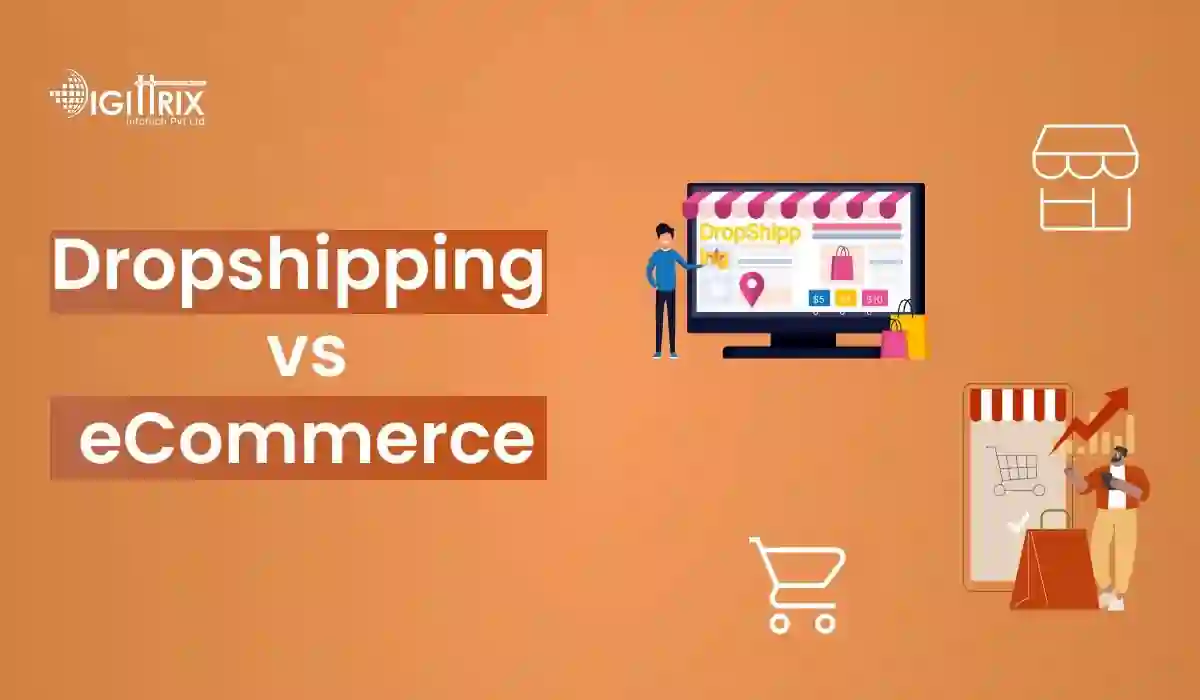Compare dropshipping and traditional eCommerce models to find the best fit for your business, exploring costs, control and fulfilment strategies.
Highlights
An enthusiastic developer and skilled business management expert with over a decade of experience in the field

E-commerce has significantly evolved over the years, providing various models to businesses and entrepreneurs who wish to sell goods online. Two of the most popular methods are dropshipping and traditional e-commerce. Each comes with its own set of advantages and challenges. Understanding the fundamental differences between these two business models is crucial for anyone looking to start or scale their online store. In this article, we will explore the key aspects of both, helping you decide which model best suits your business needs.
Dropshipping is a business model in which the retailer doesn’t hold any inventory. Instead, when a customer places an order, the retailer purchases the item from a third-party supplier who ships the product directly to the customer. This means the retailer never handles the product themselves. Dropshipping has gained popularity because it offers an easier entry point into the world of online business. To get started, businesses often rely on dropshipping website development, which helps them create a functional and user-friendly online store to effectively manage orders and communicate with suppliers. Shopify report shows that dropshipping businesses have 20-30% lower profit margins than traditional e-commerce models.
Planning an eCommerce app? Here’s your complete guide to process & cost.
Traditional eCommerce refers to operating an online store where the retailer holds inventory, manages fulfillment and ships products directly to customers. In this model, the business owner retains full control over the products and can dictate pricing, quality and delivery. To create a successful online store, investing in ecommerce platform development is crucial. A well-designed eCommerce website enables businesses to provide a seamless shopping experience, optimize product listings and integrate secure payment gateways- all essential for driving sales and building customer trust. Statista data indicates that traditional e-commerce has a 12% higher customer retention rate compared to dropshipping.
The most significant difference between dropshipping and traditional e-commerce lies in how inventory is managed. Dropshipping eliminates the need for businesses to maintain inventory, while traditional e-commerce necessitates a substantial stock investment.
In terms of initial investment, dropshipping is significantly less expensive. Because you don’t have to invest in inventory upfront, the barriers to entry are considerably lower. Traditional e-commerce requires purchasing products in bulk, which can place a significant financial burden on new businesses.
Profit margins tend to be higher in traditional e-commerce because businesses buy products in bulk and can sell them at a greater markup. However, the substantial initial investment and operational costs reduce those profits. Dropshipping, in contrast, has lower profit margins due to the higher per-unit cost charged by suppliers.
When running a traditional e-commerce business, you have complete control over the product, packaging and shipping processes. This control enables you to create a unique customer experience, build brand loyalty and ensure quality. In dropshipping, since you depend on suppliers for fulfillment, your control over the customer experience is diminished, especially regarding product quality and shipping times.
Dropshipping is a low-risk business model because you don’t have to worry about unsold inventory or upfront costs. You can easily test different products and niches without a significant investment. In contrast, traditional e-commerce businesses face higher risks due to the upfront costs of inventory and the possibility of unsold stock.
With dropshipping, the supplier manages shipping directly to the customer, saving the retailer time and money. However, this approach can result in longer shipping times and potential issues with customer satisfaction if delays occur. Traditional e-commerce businesses oversee their shipping and fulfilment processes, enabling them to ensure faster delivery times and more efficient handling.
The decision to choose dropshipping or traditional eCommerce largely depends on your business goals, resources and level of involvement in the process. If you’re just starting and want to minimize risk and investment, dropshipping could be the ideal choice. It enables you to test the waters and determine if the e-commerce world is a good fit for you.
On the other hand, if you’re looking to build a brand, gain more control over product quality and are prepared to invest in inventory and logistics, traditional eCommerce might be more suitable for your needs. It offers higher profit margins and greater control, which can be beneficial for long-term growth. Oberlo survey reveals that 22% of online businesses use dropshipping as their fulfilment model.
Regardless of the model you choose, having a reliable, professional website is crucial for your success. If you decide to pursue dropshipping, your site must be optimized for showcasing products and integrating with suppliers. For traditional e-commerce, you’ll require a platform capable of managing inventory, processing payments and efficiently handling customer data. Whether you opt for dropshipping website development or traditional eCommerce website development, collaborating with a professional web developer can ensure that your site is both functional and user-friendly.
In the battle of dropshipping vs. traditional eCommerce, there is no definitive winner. Each model has its unique advantages and challenges. Dropshipping offers a low-risk, low-cost entry point into eCommerce, while traditional eCommerce offers greater control and higher profit potential.
Ultimately, your choice depends on your budget, business goals and how much time and effort you want to invest in managing inventory and fulfillment. Whatever path you take, make sure to prioritize the right website development and web development services to support your business model.
By partnering with the right website app development experts and using custom website development solutions, you can set your business up for success, whether you're pursuing a dropshipping or traditional eCommerce model.
In 2025, a successful eCommerce website, whether for dropshipping or traditional retail, is defined not only by the products it offers but also by the intelligent design and essential features that create a seamless shopping experience. From mobile responsiveness and fast load speeds to automated inventory updates and secure checkout flows, every element plays a crucial role in converting browsers into buyers. That's where expert web design and development come into play.
Digittrix specializes in website and app development, boasting over 14 years of experience in crafting high-performing, visually appealing and fully optimized platforms for both dropshipping and traditional eCommerce businesses. Whether you are just entering the online business space or looking to upgrade your current store, we ensure your site is built to scale with top-tier design features, SEO optimization, and conversion-focused functionality.
Want to launch a dropshipping or traditional eCommerce website that stands out in 2025? Let one of the leading web and app development companies build it right from the start. Reach out to us at +91 8727000867 or email digittrix@gmail.com to schedule your consultation. With the right team behind your design, features, and strategy, you can start selling smarter and faster, with a store built for success.

Do you need help in Web Development ?




Join over 1500+ businesses we've already helped!
Dropshipping involves fulfilling orders through a third-party supplier, while traditional eCommerce requires businesses to manage inventory and shipping directly.
Dropshipping generally has lower upfront costs, as it eliminates the need to purchase inventory before sales.
Traditional eCommerce offers better control, as businesses manage their own inventory and shipping processes.
Yes, dropshipping is typically more scalable, as it does not require significant investment in inventory or warehousing.

©2025Digittrix Infotech Private Limited , All rights reserved.